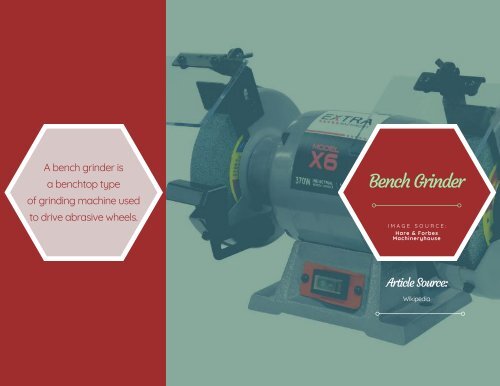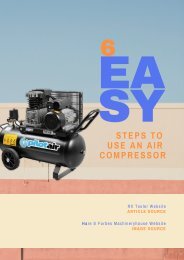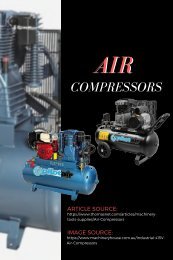You also want an ePaper? Increase the reach of your titles
YUMPU automatically turns print PDFs into web optimized ePapers that Google loves.
A bench grinder is<br />
a benchtop type<br />
of grinding machine used<br />
to drive abrasive wheels.<br />
<strong>Bench</strong> <strong>Grinder</strong><br />
I M A G E S O U R C E :<br />
Hare & Forbes<br />
Machineryhouse<br />
Article Source:<br />
Wikipedia
Depending on the bond and grade of<br />
the grinding wheel, it may be used for<br />
sharpening cutting tools such as tool<br />
bits, drill bits, chisels, and gouges.<br />
Alternatively, it may be used to roughly<br />
shape metal prior to welding or fitting.<br />
A wire brush wheel or buffing wheels can be<br />
interchanged with the grinding wheels in order to<br />
clean or polish workpieces. Stiff buffing wheels can<br />
also be used when deburring is the task at hand.<br />
Some buffing machines (buffers) are built on the<br />
same concept as bench grinders except for longer<br />
housings and arbors with buffing wheels instead of<br />
grinding wheels.<br />
A pedestal grinder is a similar or<br />
larger version of grinder that is<br />
mounted on a pedestal, which<br />
may be bolted to the floor or<br />
may sit on rubber feet. These<br />
types of grinders are<br />
commonly used to<br />
hand grind various cutting<br />
tools and perform other rough<br />
grinding.<br />
<strong>Bench</strong> grinders are standard equipment in metal<br />
fabrication shops and machine shops, as are<br />
handheld grinders (such as angle grinders and die<br />
grinders).<br />
Operation (including safety<br />
standards)<br />
WHEEL SPEED<br />
Wheels come with maximum RPM ratings printed<br />
on the label (paper blotter). The grinder's RPM<br />
must be equal or lower; "the maximum operating<br />
speeds indicated on the wheel's tag must never be<br />
exceeded".[2] Greatly overspeeding a grinding<br />
wheel makes it explode, which can injure or kill the<br />
operator like a gunshot would.<br />
WORKPIECE MATERIAL SUITED TO WHEEL<br />
GRADE<br />
The typical wheels on most bench grinders<br />
are vitreous-bond wheels. They work best to do<br />
their intended task, but they inherently have a risk<br />
of cracking. Grinding wheels designed for steel are<br />
not to be used for grinding softer metals, like<br />
aluminium. The soft metal gets lodged in the pores<br />
of the wheel and later expands with the heat of<br />
grinding. This can dislodge pieces of the grinding<br />
wheel, causing injury.
SIDES OF WHEEL VERSUS PERIPHERY<br />
Grinding is prohibited on the side of a typical (diskshaped)<br />
bench grinder wheel, which is designed<br />
for grinding on the periphery only. Risk of wheel<br />
explosion otherwise threatens. Some tool and<br />
cutter grinders have cup-shaped wheels designed<br />
to do grinding on the side.<br />
TOOL REST AND SPARK ARRESTOR PLACEMENT<br />
The tool rest needs to be tight and within 2 to 3<br />
mm of the wheel ( ⁄ " to ⁄ "). This prevents the<br />
workpiece from slipping down between the wheel<br />
and the tool rest. The spark arrestors catch stray<br />
sparks.<br />
Grinding is usually done with the workpiece resting<br />
on the tool rest. This prevents sudden slips in which<br />
the wheel grabs the work momentarily and yanks<br />
it out of the operator's hand or pulls the hand<br />
toward the wheel.<br />
WHEEL GUARDS<br />
The wheel guards serve to intercept the fragments<br />
of an exploding wheel, keeping them from killing<br />
people or damaging surroundings. This is why<br />
running a grinder without the guards is prohibited.<br />
COOLANT<br />
Grinding metal on a power-driven grinding wheel quickly<br />
heats up the workpiece. Most bench grinders are of the<br />
dry type, in which no cutting fluid (coolant) is used at the<br />
grinding interface, but often the workpiece is recurrently<br />
dunked into a pan or pot of water for cooling so as to<br />
keep it from getting hot enough to lose its temper, burn<br />
the operator's hand, or both. Such pots are often mounted<br />
just below the grinder for safe and easy reach. For<br />
medium-carbon or high-carbon workpieces that are<br />
already hardened and tempered (such as tool bits and<br />
drill bits), the dipping of the piece into the water must be<br />
frequent enough to avoid very high heat followed by<br />
substantial quenching, which can easily destroy the<br />
existing heat treatment.<br />
WHEEL DRESSING<br />
<strong>Bench</strong> grinder wheels sometimes need to be restored to roundness and given a fresh grinding face with newly exposed grains. New<br />
wheels have suitable balance when first made, but whether the balanced state will last after the wheel has been mounted, and<br />
(especially) after it has been in use for a while, is "quite uncertain".[2] It can seem counterintuitive that they could wear as unevenly as<br />
they sometimes do, but a slow spin of the resting wheel by hand confirms it by showing the gap between wheel and tool rest varying<br />
substantially as the wheel turns. Thus it is normal that wheels sometimes need to be dressed (neatly trimmed), which is achieved by<br />
any of several types of wheel dresser. When bench grinders vibrate excessively, it is usually because the wheels have worn out of round<br />
and are thus out of balance. Truing them by dressing usually resolves this problem. Although some consumers might imagine buying a<br />
bench grinder and then using it for many years without thinking about wheel dressing, the need for dressing is not so seldom as that.<br />
Correcting the imbalance not only reduces the annoyance of vibration (which rattles the wheel guards and shakes the workbench) but<br />
also is important to prevent premature failure of the spindle bearings, as heavy vibration beats them excessively.<br />
It is also possible to arrange the weight distribution of the wheels for better balancing. There are several methods of doing this, all<br />
being conceptually analogous to tire balancing with wheel weights. Most bench grinders never have these operations performed,<br />
because wheel dressing alone is enough to keep them sufficiently balanced, but these additional methods are not unusual for bench<br />
grinders and are quite common for machine tools that do grinding, such as surface grinders and cylindrical grinders. This is sometimes<br />
achieved by drilling a few holes in the steel flanges that hold the grinding wheels and then finding the angular orientation at which the<br />
holes' lack of weight balances out a heavy spot elsewhere on the rotating mass. Another method is a dedicated type of large flange<br />
with little weights that can be screwed down wherever needed for balancing (called a balancing flange.[2]<br />
WHEEL REPLACEMENT<br />
Wheels sometimes need replacing. The grinder is unplugged, and then the outer guard is removed. Typically a large nut holds the<br />
wheel on the arbor. The handedness (sense) of each nut is assigned to avoid any loosening tendency during grinder use.[2] Thus on a<br />
typical grinder the nut is left-handed on the left side of the grinder from the operator's viewpoint, with wheel rotation "toward" the<br />
operator (if the wheel could travel), whereas on the other side the nut is right-handed. "In other words, to remove the nut, it must be<br />
turned in the direction that the spindle revolves when the wheel is in operation."[2] Holding the wheel against the wrench's turning<br />
action is difficult, but usually the wrench is gently tapped with a hammer instead, which neatly taps the nut loose. A large steel flange is<br />
on either side of the wheel, then a paper washer (blotter), then the wheel. The paper is conventionally held to be absolutely necessary<br />
to prevent the steel flange from bearing directly against the wheel and tending to crack it; trained workers are expected to know and<br />
obey this rule. Thus the entire contact area between flange and wheel is covered, either with paper or with compressible coating<br />
(rubber or gasket) on the flange.[2] The wheel's inner diameter may meet the arbor precisely or may be larger with a bushing (sleeve)<br />
to reduce it.[2] Before the new wheel is mounted it is ring tested,[2] which involves gently tapping it with a fingernail or tool handle<br />
(wood or plastic) to hear its high-pitched ring (comparable to a bell's ring, although not loud), indicating that it is not cracked.[2] It is<br />
rung in various spots to be sure. A "flat" or "hoarse" sound (failing to "sing") indicates a crack.[2] With the wheel having passed the ring<br />
test, the bushing (if any), wheel, paper blotters, steel flanges, and nut are assembled, and the nut is tightened, not as hard as possible,<br />
but enough to be firmly fastened in place. The guard is reinstalled, and then the grinder can be plugged in again. Dressing may be<br />
needed afterward. When the wheel is first started, the operator stands a bit off center, so that if it were to explode, less pathway for<br />
injury exists.<br />
Some grinders for knife sharpening duty are of the wet<br />
type, in which the bottom of the wheel runs within a pan<br />
of water or other coolant. A tube may also deliver a<br />
stream of coolant near the top of the wheel. These<br />
grinders are not always called bench grinders, but they<br />
are among the class of benchtop grinding machines.





